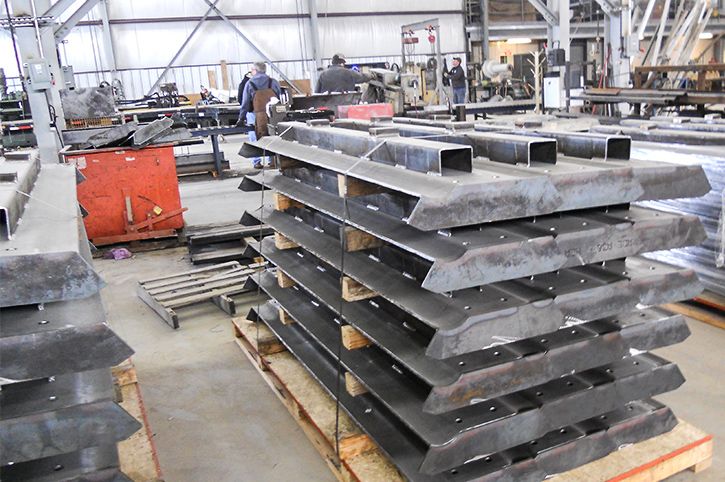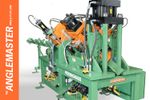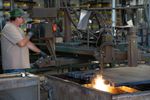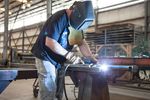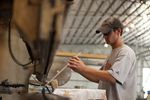While they do have other applications, conveyor bridges are most frequently used in strip mining. The conveyor bridges remove mining waste (called overburden) and transport it out to the spoil bank on an elevated track. Often, the material is crushed in the pit before being transported away, creating an In-Pit Crushing and Conveying (IPCC) system.
Constructing conveyor bridges does require a significant upfront investment, but once they’re in place, they can:
- Run continuously
- Manage energy efficiently
- Navigate rough terrain easily
Choosing the right metal fabrication partner and following best practices is critical to conveyor bridge construction success.
Conveyor Bridge vs. Truck-and-Shovel System
In surface mining, the most common alternative to a conveyor belt is a truck-and-shovel system. Trucks can be purchased up front for less of a cost than conveyor bridges. They also allow for more flexibility; you can always buy more trucks, or sell them if your capacity decreases.
However, truck-and-shovel systems come with their own drawbacks. For one, trucks are very labor-intensive, requiring multiple operating and maintenance workers in order to keep them running. They also lack fuel efficiency, as they burn significant quantities of gas and carry an empty load half the time.
Since they’re a batch load system, trucks also cause variable cycle times that can reduce productivity. For example, you may have to wait for empty trucks to make their way back down to the mine. Trucks may also queue up as they wait to be loaded, delaying production.
If you’re experiencing these problems with a truck-and-shovel system, a conveyor bridge might be the more long-term, cost-effective solution.
Conveyor Bridge Fabrication Best Practices
If your company is going to invest in a conveyor bridge, you want to make sure it will last. After all, conveyor bridges must remain outside and weather the elements successfully with little downtime. Customization is also critical for the conveyor bridge fabrication process, since each mine has its own layout, dimensions, and equipment. Each conveyor has to be designed to navigate the specific terrain of the mine, while still efficiently transporting overburden.
Each conveyor bridge also needs to be rigorously tested for quality control, ideally by outside auditors, to ensure it meets or exceeds all quality standards. Conveyor bridges must fall within a very defined measurement for tolerance and their dimensions need to be verified, so inspecting and documenting the parts thoroughly is the key to a successful fabrication. High-quality welds are especially important for conveyor bridge longevity, so ask about shop practices and make sure that inspections (including the welds) are included in the scope of work.
Look for a conveyor bridge fabrication partner who offers not just a meticulous quality control process but also qualified experts with substantial certifications, including professional welders who adhere to stringent industry standards. A full-service metal fabricator will have industrial designers and engineers that will work with your company to determine the best conveyor bridge design for your needs, including measurements, materials, and finishes.
Conveyor Bridge Fabrication Process
After you approve the engineering designs, the actual fabrication process will begin. Your fabrication partner will cut and form the trusses using plate shears and plasma cutting tables. Finishing the trusses with hot-dip galvanization is a popular choice, since it helps prevent any rust that can result from exposure to the elements.
Then, the conveyor bridge will undergo a rigorous quality control process before it’s finally ready to ship. Some fabrication partners, including Southern Metal Fabricators, may offer installation assistance for clients located in certain regions, so if that’s important to you, ask about that during your search process.
While the conveyor bridge fabrication process is complex and thorough, that doesn’t mean that it moves slowly. For instance, we worked with a customer to create 20 conveyor belt trusses in just three months, from initial contact to final delivery.
If you’d like to know more about the best practices for conveyor bridge fabrication, or you’re ready to start the quote process, give Southern Metal Fabricators a chance to say, “Yes, we can do that!” by contacting us today.
